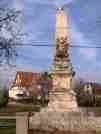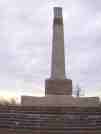|
|
|
|
|
|
|
|
|
|
|
|
|
Hungary, facts and history in brief Budapest, facts and history in brief PákozdHungary
Pákozd is a small township in Fejér county of Hungary. The settlement is on the old Budai road near Székesfehérvár, on the northern part of Lake Velence. The remains of an earthen fortress and many other articles from the middle Bronze Age were found in and around the settlement. A very important battle was won by the Hungarians against a much superior force during the 1848-9 Freedom Fight. The main M7 Motorway is nearby. The first written records are from 1279. Sights include Ruins of Bronze Age fortress Battle of Pákozd Obelisk Battle of Pakozd Museum Natural reserve Bird sanctuary Lake Velence and many others. Country: Hungary Region: Central Trans Danubia County: Fejér Rank: Village Area: 43,32 km² Population: 2762 (2001) Post code: 8095 Dialling code: 22
2006
The Battle of Pákozd took place on September 29, 1848 during the Revolution of 1848, near Pákozd in central Hungary. The outcome, a Hungarian victory, was an important victory for the outnumbered Hungarian troops against the forces of Ban Josip Jelačić. When Jelačić's Croatian troops entered Hungary following the September 11 declaration of war in the name of the Habsburg Empire, many of the Hungarian generals were not willing to attack the imperial troops to which they had sworn allegiance (notably general Ádám Teleki, commander of the forces on the Dráva). The battle is a landmark of loyalty: the ban of Croatia, Josip Jelačić, who led the Croatian army, was sent to deal with the rebellious Hungarians, which he promptly did, despite the fact that, had he sided with them, and against the Emperor, Croatia very well could have won its independence from the Habsburgs in 1848. The ban's choice to obey the Empire by attacking Hungary is a pivotal moment in the history of the Habsburg monarchy; the Empire owed a great debt to him. After the battle of Pákozd, the halted Croatian armies were forced to retreat towards Austria, where they were given new orders from the Austrian government, but no reinforcements as they were promised. All text is available under the terms of the GNU Free Documentation License (see Copyrights for details). About Wikipedia Disclaimers 
 The Battle of Pákozd, perpetuated by a monument in the heart
of the village Pákozd (on the left) and another large Obelisk on the
nearby hilltop, scene of the battles(on the right).
The Battle of Pákozd, perpetuated by a monument in the heart
of the village Pákozd (on the left) and another large Obelisk on the
nearby hilltop, scene of the battles(on the right).
The museum is situated in the Pákozd Memorial Park a few hundred metres from the Memorial Statue.
The Germans were making spectacular gains in their Operation Barbarossa until the winter of 1942 - 1943 at the gates of Leningrad and Moscow. .....According one source; Germany needed to call on their allies, including the until-now neutral Hungary for some military contribution..... According another story; Kassa (Kosice now) was bombed by the Soviet Airforce and Admiral Horthy mobilised the 2nd Hungarian Army, in retaliation, calling up reserves in about even numbers from the districts of Szombathely, Miskolc and Pécs to spread mobilisation more or less evenly across the country. The 2nd Army consisted of 207,000 men according to Hungarian sources. ".....On 12 January 1943, the Soviets then launched the second stage of Operation Saturn. In this stage the four armies of Soviet General Filipp Golikov's Voronezh Front attacked, encircled, and destroyed the Hungarian Second Army near Svoboda on the Don. An attack on the German 2nd Army further north threatened to bring about an encirclement of that army as well. But the German 2nd Army managed to escape and it was forced to retreat. By 5 February 1943, troops of the Voronezh Front were approaching Kursk and Kharkov....." ".....With the success of the second stage of Operation Saturn, approximately 120,000 Hungarians were killed, wounded, or captured. The Hungarian Second Army, like most of the other Axis armies protecting the German Sixth Army's flanks, ceased to represent a meaningful fighting force. The agony of the Sixth Army trapped in Stalingrad had ended when they surrendered on 2 February 1943....." Excerpted from Wikipedia, the free encyclopedia. I don't know the reason, the thinking or the rationale behind putting this Chapel here, to me it's a bit ironic to place the Memorial Chapel of one of the greatest defeat in close proximity of one of the greatest victory.
The bell of the small and very beautiful chapel is dedicated to Vitéz Admiral nagybányai Miklós Horthy, Regent of Hungary during most of the war years. There's a Kopjafa (A traditionally carved wooden memorial) in the Don-kanyar-emlékkápolna - Don Band Memorial Chapel grounds dedicated to István Horthy (Vitéz nagybányai Horthy István), Vitéz Admiral nagybányai Horthy Miklós's eldest son, a politician and, during World War II, a fighter pilot. He died when his plane was shot down on the Eastern Front near Kiev. Site Index Back to Top Photos Index Thanks for coming, I hope you
have enjoyed it, will recommend
it to your friends, and will come
back later to see my site developing
and expanding.
|